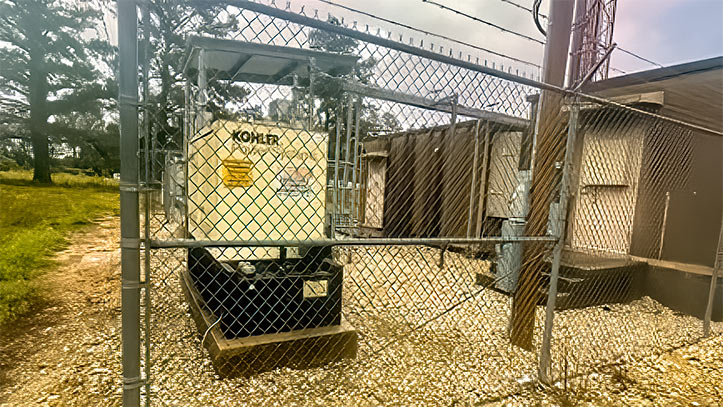
A MasTec Network Solutions tower technician fell from this Crown Castle 500-foot guyed tower in Texas. His death is being investigated by OSHA. Photo: Trinity County Sheriff’s Office
UPDATE: November 11, 2024 – Services have been set for James Belecher, the 38-year-old tower technician supervisor who died on a Crown Castle site while working for MasTec Network Solutions.
A tower technician is dead today after having fallen from a guyed tower, according to Trinity County Texas Sheriff Woody Wallace.
According to a press statement, the Trinity County Sheriff’s Office received a call for a welfare check at a tower at 7587 State Highway 94 around 7:15 a.m. from MasTec Network Solutions.
The MasTec employee said that one of their technicians did not return home yesterday evening, and the tower was his last known assigned project location.
Upon arrival, deputies found the man deceased. According to the release, a preliminary investigation shows that the man had been climbing the tower and appeared to have fallen on a platform about eight feet in the air.
They did not identify whether it was a waveguide bridge or other covering structure on the multi-tenant site.
Authorities and MasTec did not respond to Wireless Estimator’s requests for additional information.
The 500-foot guyed tower, built in 1997, is owned by Crown Castle.
The deceased was the second industry fatality in 2024.
Initial industry reaction: Why was he working alone?
Multiple Facebook posts questioned why the tower technician was working alone, and others described violated regulations that, although well intended, were not accurate, according to safety professionals, who informed Wireless Estimator that the minimum criteria are identified in ANSI/ASSE A 10.48 Criteria for Safety Practices with the Construction, Demolition, Modification, and Maintenance of Communications Structures.
A10.48 is very specific about requirements for fall protection when working on a telecommunication structure. The standard states a minimum of a 2-person crew when working at height.
Although it does not specify the elevation of at height, OSHA sets 6’ for the construction industry. In addition to a through investigation, OSHA is expected to review, as a minimum, some of the items below in bold.
The employer’s responsibility, according to A10.48
6.2.3. Employer. The employer with employees exposed to fall hazards shall provide for
prompt rescue of employees in the event of a fall or shall assure that employees are able to rescue themselves including, at a minimum:
a) Ensure personal protective equipment (PPE) and rescue equipment needed to conduct elevated rescues are provided, used, and maintained
b) Ensure exposed employees are trained, equipped, and are utilizing their fall protection equipment in accordance with the NATE Climber/Rescue Climber Training Standard (CRTS) and/or the ANSI/ASSP Z359.2 standard.
c) Provide specific training relevant to the employee’s responsibilities based upon their designated level of competency in accordance with the climbing and rescue methods to be utilized.
d) The employer shall provide at a minimum for a two-person crew working at height, one competent climber/rescuer and one authorized climber/rescuer and for crews of three or more working at height, a minimum of two competent climber/rescuers are required.
e) Ensure authorized climber(s) are supervised by a competent climber when working at height.
f) Develop a site-specific fall protection and rescue plan for all applicable individuals on site where employees are exposed to a fall from height.
g) Designate a competent person(s) who has met the employer’s requirements regarding fall protection and has been granted authorization to stop work and take corrective action, to ensure work at height is completed in accordance with the fall protection and rescue plan.
h) Designate the individuals required for the project, including but not limited to, authorized climber, competent climber, authorized rescuer and competent rescuer.
The Fall Protection Plan
6.3.
Fall Protection Plan Requirements
6.3.1. Documentation. When personnel are exposed to a potential fall from height, as defined by the applicable standards, a fall protection plan shall be developed, documented, and readily available to ensure all necessary facilities, equipment, and trained personnel are in place for maintaining continuous fall protection. The fall protection plan shall address, at minimum, the following:
a) Type of structure.
b) Emergency services contact information.
c) Known fall protection hazards along with planned means to control or mitigate such hazards.
d) Competent and authorized climber(s) on site.
e) Planned type(s) of climbing/access facilities to be utilized including, but not limited to, rung and rail climbing facility, step bolt climbing facility, personnel platform, elevator and/or aerial lift.
f) Known climbing facility obstructions to the climbing path(s).
g) Transition methods between climbing/access facilities.
h) Fall protection equipment including:
*Fall arrest system(s) to be utilized including, but not limited to, energy absorbing lanyard(s), lifeline(s), and/or ladder safety system(s).
*Work positioning system(s) to be utilized including, but not limited to, positioning lanyard(s), spreaders and hooks/carabiners.
i) Permanent and/or temporary anchorages to be utilized with fall arrest and work positioning systems.

















